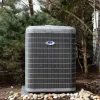Nowadays a lot of air conditioners from the R-22 era are starting to have problems. That shouldn’t come as a surprise since those air conditioners are all (in 2023) at least 13 years old!
Since 2010, no HVAC company has installed an AC that used R-22 refrigerant. To comply with EPA regulations, we went completely over to R-410A, which is a more eco-friendly refrigerant type. Then, in 2020, EPA rules began prohibiting the production, sale, or importing of new R-22 refrigerant.
R-22 is an obsolete product. It’s spent. Over and done. Dead.
And yet…
There is still some demand for R-22 refrigerant in the marketplace. When old ACs start leaking refrigerant, many people aren’t ready to replace the system. They want to top off the R-22 that’s leaking out as a stop-gap measure. Others might ask about refrigerants they can use instead of R-22, given that the banned substance is increasingly scarce.
So… what refrigerant can be mixed with R-22?
None.
You can’t mix refrigerants. Case closed, right?
Ok. We get it. Maybe you don’t want to mix the refrigerants. You just want to use an alternative refrigerant that will work in an old R-22 air conditioning system. In that case, the answer is a little bit different.
It is possible to use a different type of refrigerant inside an R-22 system. There are “drop-in” refrigerants that serve exactly this purpose. When someone has an R-22 leak, it’s possible to remove all the R-22 from the system and replace it with a drop-in refrigerant. This allows you to keep your existing AC without having to source R-22 and pay exorbitant costs to get it.
But there are problems with this approach.
Why you don’t want to use a drop-in refrigerant
Here are a few reasons you should not use a drop-in when you have an R-22 leak:
It’s a pretty big undertaking
To properly use a drop-in refrigerant, your HVAC technician will have to do a full recovery operation on the air conditioning system. This means removing the R-22 refrigerant, fixing the leak (if possible) or replacing the coil (expensive!), and recharging the system with a new refrigerant.
Can you do this? Sure. But it’s not cheap. It’s also kind of like replacing the transmission in your ‘86 Plymouth Horizon. Unless you have a sentimental attachment to your air conditioner, it’s just not very cost effective.
And let’s not forget that in many cases…
The system is still going to leak
If it’s not possible to fix the leak and you’re not willing to spring for a new coil, you’ll just end up calling an HVAC technician to periodically top it off with the drop-in refrigerant.
In this scenario, you haven’t fixed the problem. It’s a band-aid solution, and a potentially costly one.
You lose cooling capacity
The air conditioner isn’t going to work as well as it did with R-22. With a drop-in refrigerant, you will experience a 5 to 7% reduction in cooling capacity at best.
Not everybody stocks the same drop-ins
Let’s say you went with a drop-in from Company A. Well, what happens the next time you need a refrigerant top-off and Company A can’t make it to your house right away?
Well, you might call Company B instead. However, when Company B’s technician shows up to top off your system, it turns out he doesn’t have the right type of drop-in refrigerant in stock.
Since there’s no consistency with the types of drop-ins that are on the market, managing your air conditioning system can get really complicated.
You might void your warranty
Most R-22 systems are no longer under warranty these days. But if yours is, you will void the warranty on the compressor if it’s made for a specific type of refrigerant and a specific pressure.
You might find yourself in this scenario if you replaced the compressor a few years ago while it was still under warranty. If you have a refrigerant leak and are considering a drop-in product, you might void the warranty on that new-ish compressor from a few years back.
What you should do instead of using a drop-in refrigerant
When you have a refrigerant leak in an R-22 air conditioner, the best solution is to replace it with a new system.
Today’s air conditioning systems use R-410A refrigerant. It’s widely available, affordable, and it’s not going anywhere any time soon. Later on, if you have a refrigerant leak and the system is still under warranty, you can usually replace the evaporator coil and recharge the system with R-410A.
No drop-ins. No top-offs. No sitting around hoping some ancient, rusty machine will somehow make it through another summer.
Mixing refrigerants is always a no-no. Drop-ins aren’t so great either.
R-22 air conditioning systems are headed to the dustbin of HVAC history. If your old AC has a refrigerant leak and your warranty has expired, the best thing to do is invest in a new system and a professional installation.
If you live in Metro Atlanta and are concerned about your old AC, give us a call at (404) 994-2229 today or fill out the form below!






